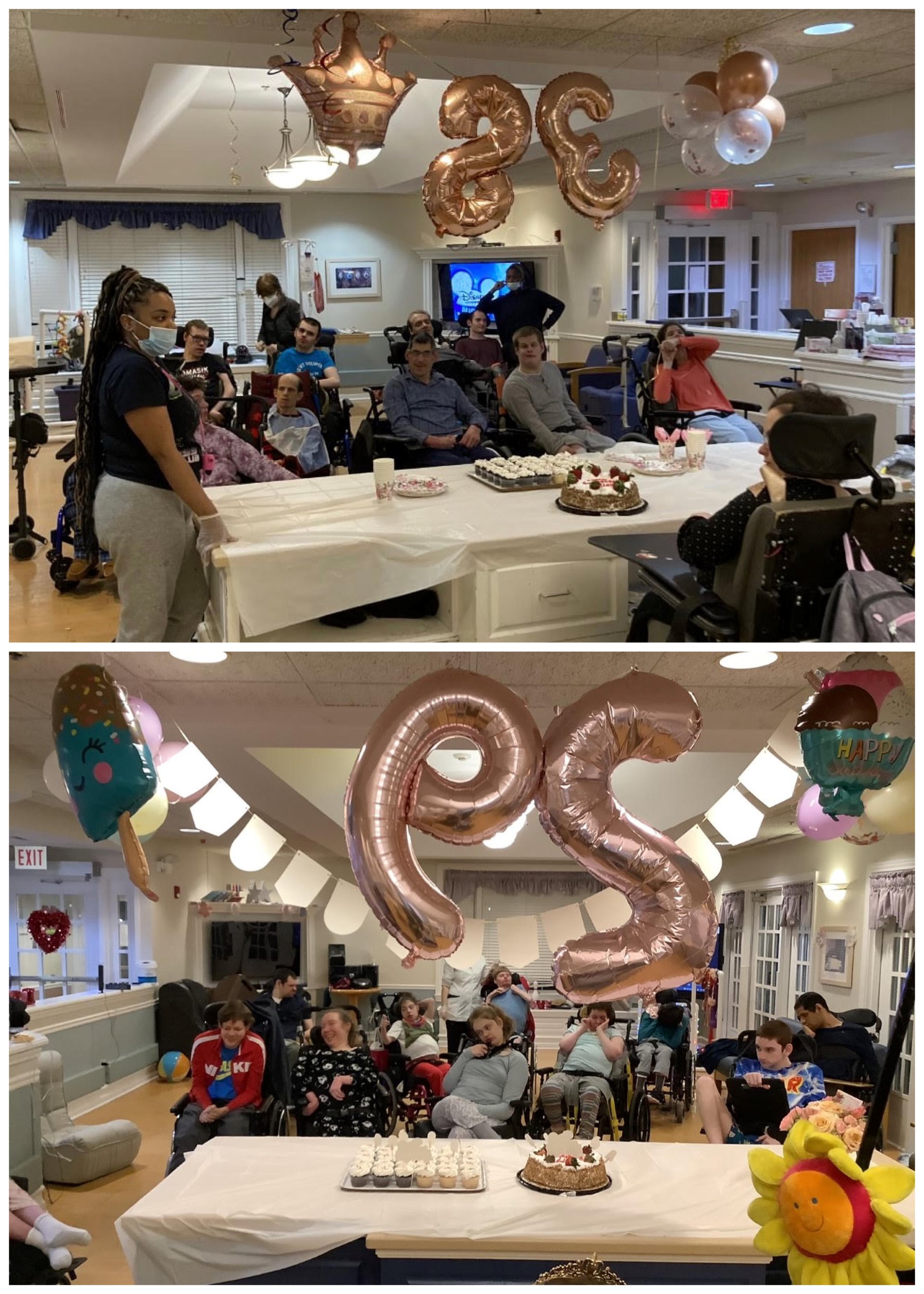The MFA Site Reps: Keeping Us Connected to Our Residents and Staff

by Barb Quaintance
One of the most important roles on the Misericordia Family Association (MFA) Board is that of a Site Representative. There is a Site Rep, or Site Rep couple, for each of the residential areas: CILAs, Marian Center, McAuley, Mercy Glen, Rosemary Connelly/McGowan, Quinlan Terrace, Shannon Apartments, and the Village.
The Site Reps are communicators and organizers. They attend MFA Board meetings and share pertinent information and Board decisions with families/guardians in their residential area. They also participate in the Nominating Committee and staff family tables at the MFA general meetings. The Site Reps work with families to recognize and support the staff.
Fall Fun for CILA Families 

by Sue Hartemayer
On Sunday, October 6, Misericordia CILA residents and their families gathered at the Walsh-Slattery CILA in Lincolnwood for a Good Ole’ Fashioned Picnic! A glorious, autumn day brought 175 residents, parents and assorted staff members together for food, games, music and merriment. Lunch was provided by Chipotle, and no one went home hungry. Games were played on the spacious Walsh-Slattery lawn, while the crowd was entertained by music from Misericordia’s very own resident, "Dj-Hermannator-X". Two television viewing areas inside kept the group apprised of "Da Bears" game, and a good time was had by all!
CILA Living - What's It All About? 

by Sue Hartemeyer and Merrily Smith
The acronym, CILA, stands for Community Integrated Living Arrangement. The first one opened in 1996. It was called Hulseman-Murphy and was donated by the family who invented Red Solo Cups. Since then, the following CILAs were added:
1998 McAllister
2002 Farrow
2004 Walsh
2006 Houlihan
2007 Maxwell
2009 Eisenberg
The…in the 2010’s:
Baumgartner, Gerber-Hoag, Leland, Madden, Moore, Rafferty and Walsh-Slattery followed.
With the opening of the Cohen Home in February, the total number of CILAs will now be 15.
CILA Homes Open Hearts and Doors

by Kathryn and John Moery
On a beautiful August afternoon, 25 CILA families made their journey to visit CILA homes operated by Misericordia. These families had chosen to tour up to four houses of the nine houses participating in the inaugural CILA Open House event on August 13. The houses on the tour were open for three hours, and the families were scheduled in advance to tour in one of the four time blocks offered. Invitations for the event were sent out electronically in late June, and families RSVP’d with their house selections and the timeframes in which they preferred to visit. As the MFA CILA Site Representatives, we coordinated this event, with the support of Joe Ferrara, the CILA Administrator, and Diane Carpenter, MFA IT Support. Lead families, QIDPs and DSPs were instrumental in preparing and facilitating this event in each of the houses.
The Open House concept was inspired by our quarterly virtual meetings with the CILA families over the past two years, and borne from the frustration of finding a way to stage an in-person family gathering during the pandemic. CILAs, Community Integrated Living Arrangements, are homes in surrounding neighborhoods, licensed by the state Department of Human Services. It was a challenge to conceive of a way to get 82 residents and their families living in 14 homes within five miles of campus together after the pandemic restrictions had been lifted last spring.
Heart of Mercy Village: Suburbia on the Misericordia Campus

by Linda Buchalo
Our last stop on the tour of Misericordia residences is the Heart of Mercy Village. You might mistake the nine homes that make up the Village as a suburban development, but look again—these lovely homes are nestled together within the Misericordia campus. The homes were built in 1983–1984 on the northeast corner of the campus. Each home is unique, primarily brick, but differs slightly, making this part of campus look very much like a typical neighborhood. Each home has its own patio for outdoor dining or taking advantage of nice weather.
Within the last ten years, the homes were remodeled. The wallpaper came down to make way for a more modern look. The patios were updated—each now has two large tables, a rocking swing, and a grill. Amina Grace Gardens was constructed within the Village and provides a beautiful landscape with various plantings, including pear trees and vegetable gardens.
Rosemary/Connelly: A Fun-Loving Group

by Linda Buchalo
The Rosemary and Connelly Homes were built in 2001, funded by several benefactors. This living area consists of two adjoining buildings situated on the Misericordia campus. The homes were originally built to meet the needs of 32 children and adults with intellectual and developmental disabilities and significant physical challenges. The homes are now licensed for adults only and have a combined population of 32 adults. The homes are co-ed, and its residents are non-ambulatory. Each house has a dedicated group of trained staff who work to provide specialized care and support for each resident, and to create a comfortable, safe home environment.
McGowan Home: Small but Mighty

by Linda Buchalo
Following a long holiday hiatus, we’ll continue our tour of the residential living areas on the Misericordia campus. Today, we’ll visit McGowan Home, built in the summer of 1998. The home is brick construction with large windows so that the residents can easily view the outdoors. McGowan has 16 adult residents, both men and women, all of whom have physical disabilities with similar needs. The residence has a common living room, dining room, and bedrooms with accessible bathrooms. The house was built with spacious areas to accommodate positioning equipment and therapy needs. There is also an office for the QIDP. McGowan has a garden area where residents can gather to enjoy nature and spend time outdoors.
McAuley Residence: Where It All Started

by Linda Buchalo
This visit takes us to the largest living area on campus—McAuley Residence, built in 2004. The building, situated at the back of the campus, was constructed specifically to meet the needs of its current residents. McAuley was first occupied in 2005, as Misericordia South had outgrown its original location on 47th Street on the south side of Chicago.
McAuley is divided into six neighborhoods, with each unit named after the benefactor for that neighborhood. Included are one all-male neighborhood, one all-female, and four co-ed. Each neighborhood can serve 20–21 residents. Each has bedrooms with 2–4 residents and one single room, which allows for hospice services, as needed. Four neighborhoods have wall-equipped oxygen to serve those who require more nursing care. The current population is 113, although McAuley is licensed to serve 125 people. The ratio of staff to residents is 1 to 5 on the AM and PM shifts. The overnight shift has 2 CNAs on each unit and a nurse is assigned to each unit 24/7.
Shannon Apartments: The Party Place

by Linda Buchalo
The Shannon Apartment building was constructed in 1991, thanks to the generosity of Brian and Sue Shannon. The building is situated on the perimeter of the campus, directly across the road from the Moore Aquatic and Fitness Center.
Shannon Apartments is currently home to 56 male and female residents who are moderately independent and able to perform daily living activities with limited assistance. Staff are available to provide guidance, supervision, training, and other assistance. The apartments are also home to some very special residents, including Sr. Rosemary and Fr. Jack.
While Shannon Apartments has had various renovations over the years, the basic structure of the building has remained the same - a multi-unit dwelling with a large common gathering and dining area. Residents live within their own apartment, and these vary in size, serving between one to five people. The building is co-ed but each apartment is all male or all female. Each apartment has its own living room, dining room, and kitchen, in addition to the bedrooms and bathrooms. There are several offices and a meeting room on the main level. The lower level has a social center, game room, computer room, and three-lane bowling alley. These rooms are well-used, but during the recent pandemic, residents were especially appreciative of these extra amenities.
Life at Mercy Glen

by Linda Buchalo
Our next stop on the tour of Misericordia residences takes us to Mercy Glen, the home of 47 very fun-loving and outgoing individuals. This group definitely enjoys life to the fullest.
Mercy Glen comprises four ranch-style homes that were constructed in 2010. Three of the homes are all-male and the fourth serves female residents. Each home has a main living area and kitchens as well as a large lower-level social area. The bedrooms are divided into single and double rooms, for a total of twelve beds per house. Patios and gardens provide a place for gathering outdoors.
Each home is staffed by three people per shift. The residents at Mercy Glen benefit by additional support from staff for activities of daily living and navigation within the campus. All the homes are a short walk to support services and the campus amenities, maximizing the quality of life for Mercy Glen residents.
Page 1 of 2


